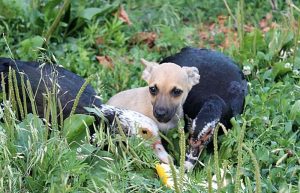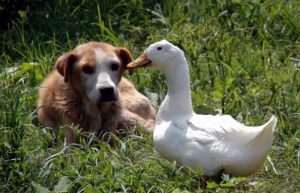What You Need to Know About Ducks and Dogs Getting Along
When you have two different species of pets, it’s always nice to know that you can trust the animals to get along. When it comes to ducks and dogs, however, you may not know what to expect. One of them is a predator while the other is prey. Before you decide to have your animals co-exist, it’s important to know what to expect out of a relationship between the two.
Do ducks and dogs get along with each other? When raised from an early age together so that they can be properly socialized, ducks and dogs can get along great. Dogs can even be used as livestock guardian animals for your ducks. If not properly introduced to a duck flock, a dog’s natural instinct would be to chase and even kill a duck.
Raising your ducks and dogs together can be done; however, it takes diligent planning and time commitment to see to the proper integration of the two different species. In this article, I’ll cover everything I know about getting your ducks and dogs to get along.
Can Ducks and Dogs to Co-Exist?
Yes, ducks and dogs can co-exist! But, you may be wondering how you make that relationship happen between your own pets. Here are some things to consider and be aware of as you think about introducing your dogs to pet ducks:
Understand the Different Natures of Both Ducks and Dogs
The most important thing to remember when it comes to working out a relationship between a pet dog and a pet duck is that these animals are from two different species. The dog is a predator while the duck is prey, so it’s not natural for them to get along. However, I’ve seen and heard many testimonies of the two animals thriving together when trained correctly. Here’s what you need to know about the two animals:
Dogs As Predators
Dogs are natural predators. This means it’s in their nature to hunt for prey and chase animals that run from them. It’s even in their nature to kill in order to eat. As meat-eaters, dogs have sharp teeth that are made to be able to rip meat.
The good news is that dogs have had a lot of time to forget about their once natural instincts. According to history, dogs were the first animals to be domesticated. This means that the instinct to kill has left some dogs. I see a lot of dogs that will chase and play with ducks but would never try to intentionally kill one.
That being said, if you have a dog that has a history of killing other animals, they may not be the best dog to try and integrate your ducks with.
Ducks As Prey
Ducks, like all poultry birds, are considered prey animals. This means they tend to browse and graze for their food rather than hunting. They also like to live in a community of other ducks for extra protection and awareness of their surroundings.
While some ducks may hiss and put up a fight against an annoying dog, most ducks will run or fly away at any sign of danger. Adult ducks may be particularly wary of a dog if they have never been introduced.
Introduce Ducks and Dogs When Both Animals Are Young
Young animals have yet to learn to protect and fend for themselves, so this is the best time to introduce your pets to each other. While this isn’t always possible, introducing a puppy to a set of ducklings has been proven to be the most effective way to form a positive relationship between the two animals.
As babies, both animals are still impressionable. This means that they can form a bond with the other animal. Animals learn by repetition, so making sure your puppy and ducklings spend time together each day can ensure they become familiar with the other animal.
Introduce Older Dogs Gradually to Ducks
It can be harder to get an adult dog to accept a duck without trying to chase or eat it, but it can be done. With my dog, I gradually introduced her to the poultry. I started out by just tying her up on the other side of the bird enclosure and letting her get used to seeing the birds on a daily basis.
Once she stopped wanting to chase them, I took one of the ducks out and let her sniff it. Next, I walked her on a leash in the enclosure to see how she would react around a bunch of dogs. I did this for a while before she finally calmed down around them. From there, I let her off the leash, but only for a minute in the beginning.
While this method worked great for my dog, you may have to try a few other methods to see which works best for your dog. My dog is extremely passive with other animals, so it was easy to train her to accept the ducks.
Best Training Methods to Teach Your Dog to Accept Pet Ducks
I have heard of other people who have had great success using other training methods to get their dogs to accept their ducks. In this section, I share an overview of each method I’ve heard about:
Clicker Training
I have personally used clicker training with some of my animals, and I do find it quite effective. With clicker training, you click a clicker to reward your dog. This is also called positive reinforcement training since you would click and give the dog a treat every time they do something correctly.
To start clicker training your dog, you have to teach them that every time they hear the click, they get a reward. You can use this with training your dog to accept ducks by clicking the clicker when they leave the ducks alone.
In the beginning, you’ll reward the dog frequently by clicking and giving treats. As the dog starts to learn what the correct behavior is, you can lengthen the time between clicks and treats. Pretty soon, the dog will understand that the correct behavior is to leave the ducks alone.
Shock Collar
If you have a dog that is more instinct-driven, you may find a shock collar to be more effective. A shock collar is a battery-operated collar that goes around your dog’s neck and will deliver a shock every time you press a button on the collar remote.
When it comes to properly using a shock collar, you can’t just shock your dog will-nilly! Shock collars have a few different levels. This first level would be a warning beep. When you hit this button on the remote, the collar will beep at the dog, warning them that they will get shocked if they continue the behavior. The next level is a low shock. As the levels go up, the shock becomes more intense.
To properly train your dog to respect the shock collar, you must always give the warning beep first. Then, if the dog continues the negative behavior, administer the shock. This will teach the dog to respond at the beep rather than waiting until they get shocked.
So, if you notice your dog starting to nag the ducks, give the warning signal. If they don’t respond, then administer the lowest shock level. If they still don’t respond, gradually increase the shock level until they finally decide to respond.
Best Guardian Dogs For Your Ducks
 Since ducks are prey animals, they are often targeted by other predators like cats, coyotes, raccoons, snakes, wild dogs, opossums, owls, eagles, and hawks. One option to protecting your duck flock is to train your dog to be a guardian animal. In this role, it will be the dog’s job to protect and defend the ducks from predators. This means your dog will live closely alongside your ducks to provide them with the necessary protection.
Since ducks are prey animals, they are often targeted by other predators like cats, coyotes, raccoons, snakes, wild dogs, opossums, owls, eagles, and hawks. One option to protecting your duck flock is to train your dog to be a guardian animal. In this role, it will be the dog’s job to protect and defend the ducks from predators. This means your dog will live closely alongside your ducks to provide them with the necessary protection.
While any dog could act as a guardian animal, there are certain dog breeds that have been bred for this specific purpose. If you’re in the market for a guardian dog specifically, here are some of the breeds to consider:
Great Pyrenees
As perhaps the most popular livestock and poultry guardian dog, Great Pyrenees is a great breed of dog to get if you’re looking for a way to protect your ducks. These dogs are very large with a signature thick white coat. An interesting fact about Great Pyrenees dogs is that they tend to stay up at night, which can make them effective at protecting your ducks from nocturnal predators.
Anatolian Sheperd
This is another large dog breed that is usually light brown in color with darker markings around its face and ears. This breed is known to be more independent from its owners, making it a good choice to live out with livestock or poultry 24/7.
Kangal
These dogs look very similar to Anatolian Shepards, having a brown coat with darker markings. Kangals are known for their loyalty, easily bonding with other animals, even of different species.
Tibetan Mastiff
These are massive wooly dogs originally bred to fight off large predators. Tibetan Mastiffs are rugged animals designed to live out in the elements with livestock and poultry. While they are known to be great guardian dogs, they also have a reputation for being more difficult to train.
Did you know there are other guardian animals besides dogs that can protect your ducks? To learn more, check out my article What Are the Best Livestock Guardian Animals?
Should My Dog Live Out With My Ducks 24/7?
If you want to get your dog used to your flock of ducks or you want to use your dog as a guardian animal, you may be wondering how often your dog should be out with your ducks.
Guardian dogs will often live out with the poultry 24/7, staying in the enclosure or in the yard if your ducks are free-range. If you are trying to introduce puppies to your poultry, it’s common for people to leave the dogs out with the birds until it seems like the animals have developed a good relationship.
All that said, your dog doesn’t have to live out with the ducks all the time. Your dog that lives primarily in the house can learn to accept the ducks and get along with them as long as they are trained properly. Although, it is important to remember that repetition and familiarity are key to quickly and effectively train your dog to accept ducks.
Pets and farm animals that can co-exist successfully will save you a lot of stress, space, and time. If you’re wanting to research other species that can live together, check out the articles below:

